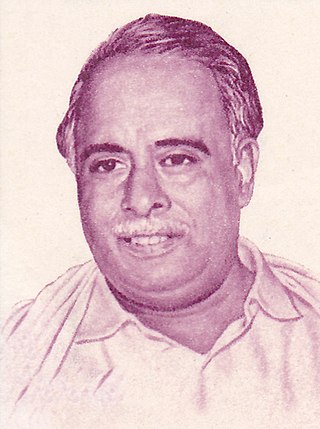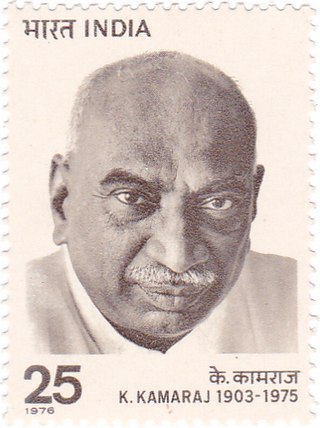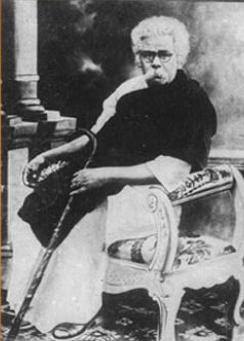
The Dravida Munnetra Kazhagam is an Indian political party based in the state of Tamil Nadu, where it is currently the ruling party, and the union territory of Puducherry, where it is currently the main opposition.

Dravidar Kazhagam is a social movement founded by E. V. Ramasami, also called Thanthai Periyar. Its original goals were to eradicate the ills of the existing caste system including untouchability and on a grander scale to obtain a "Dravida Nadu" from the Madras Presidency. Dravidar Kazhagam would in turn give birth to many other political parties, including Dravida Munnetra Kazhagam and later the All India Anna Dravida Munnetra Kazhagam.

Conjeevaram Natarajan Annadurai, popularly known as Anna, also known as Perarignar Anna, was an Indian politician who served as the fourth and last Chief Minister of Madras State from 1967 until 1969 and first Chief Minister of Tamil Nadu for 20 days before his death. He was the first member of a Dravidian party to hold either post.
Politics in South India is typically dominated by regional parties than by the larger national political parties such as the Indian National Congress (INC), Communist Party of India (Marxist) or Bharatiya Janata Party (BJP). However, both the BJP, INC and CPI(M) have had some success in forging alliances with regional parties. Unlike in North India, where religion plays an important role in driving local politics, South India's political issues of contention are mainly language and ethnicity.
The anti-Hindi-imposition agitations in Tamil Nadu have been ongoing intermittently in the southern Indian state of Tamil Nadu since the early 20th century. The agitations involve several mass protests, riots, student and political movements in Tamil Nadu concerning the official status of Hindi in the state.
Dravidian nationalism, or Dravidianism, developed in Madras Presidency which comprises the four major ethno-linguistic groups in South India. This idea was popularized during the 1930s to 1950s by a series of widespread and popular movements and organizations that contended that the South Indians formed a racial and a cultural entity that was different from the North Indians. Dravidianists argue that the Brahmins and other upper castes were originally Aryan migrants from outside of India, and that they imposed their language, Sanskrit, religion and heritage on the Dravidian people. The claim is based on widespread evidence of the genetic differences between North and South Indians, the linguistic differences between the two regions, and the fact that Indo Aryan Languages share a common ancestor with European languages such as English and likely originated outside of India. The hypothesis has ancient origins based on Sangam literature and the concept of Tamilakam but was codified in its modern form by E. V. Ramasami Periyar. The theory is contested by supporters of Hindutva who see it as a threat to Hindu essentialism.
Dravida Nadu is the name of a proposed sovereign state demanded by the Justice Party led by the founder of the self-respect movement, E.V. Ramasamy Periyar, and the Dravida Munnetra Kazhagam (DMK) led by C. N. Annadurai for the speakers of the Dravidian languages in South India.
Politics of Tamil Nadu is the politics related to the Indian state of Tamil Nadu.
Dravidian parties include an array of regional political parties in the state of Tamil Nadu, India, which trace their origins and ideologies either directly or indirectly to the Justice Party and the Dravidian movement of C. Natesanar and Periyar E. V. Ramasamy. The Dravidian movement was based on the linguistic divide in India, where most of the Northern Indian, Eastern Indian and Western Indian languages are classified as Indo-Aryan, whereas the South Indian languages are classified as Dravidian. Dravidian politics has developed by associating itself to the Dravidian community. The original goal of Dravidian politics was to achieve social equality, but it later championed the cause of ending the domination of North India over the politics and economy of the South Indian province known as Madras Presidency.
Erode Venkatappa Krishnasamy Sampath(c. 5 March 1926 – 23 February 1977), usually referred to as E. V. K. Sampath was a prominent politician from Tamil Nadu, India. He was an advocate of the Dravidian Movement of Periyar E. V. Ramasamy and was considered by some as his political heir. He later split from Periyar's Dravidar Kazhagam to form Dravida Munnetra Kazhagam (DMK) along with C. N. Annadurai. In spite of being one of the founders of DMK he later left and formed his own party, by the name, Tamil National Party. Nevertheless, he later merged his party with the Indian National Congress. He is a former Member of Parliament from the constituency of Namakkal.

Erode Venkatappa Ramasamy, revered by his followers as Periyar or Thanthai Periyar, was an Indian social activist and politician who started the Self-Respect Movement and Dravidar Kazhagam. He is known as the 'Father of the Dravidian movement'. He rebelled against Brahmin dominance and gender and caste inequality in Tamil Nadu. Since 2021, the Indian state of Tamil Nadu celebrates his birth anniversary as 'Social Justice Day'.

Periyar is a 2007 Indian Tamil-language biographical film, made about the life of the social reformer and rationalist Periyar E. V. Ramasamy with Sathyaraj who himself is a rationalist in the lead role. This movie was partly funded by the then Tamil Nadu government headed by Karunanidhi. The film was dubbed in Telugu and released as Periyar Ramaswamy Naicker.
Tamil National Party was a short-lived political party formed in 1961 in Tamil Nadu, India. The party finds its roots with the split in Dravidar Kazhagam after which Dravida Munnetra Kazhagam (DMK) was formed. E. V. K. Sampath, a founding member of the Dravida Munnetra Kazhagam, left the party following differences with the party leadership. The differences arose due to the DMK's stance on achieving an independent nation called Dravida Nadu. Nevertheless, within years the Tamil National Party was merged with Indian National Congress.

The fourth legislative assembly election of Madras State was held in February 1967. The Dravida Munnetra Kazhagam (DMK) led coalition under the leadership of C.N. Annadurai won the election defeating the Indian National Congress (Congress). Anti-Hindi agitations, the rising prices of essential commodities, and a shortage of rice were the dominant issues. K. Kamaraj's resignation as the Chief Minister in 1963, to concentrate on party affairs, along with persistent rumors of corruption had weakened the incumbent Congress Government. This was the second time after Communist Party of India winning Kerala assembly elections in 1957, for a non-Congress party to gain the majority in a state in India, and the last time that Congress held power in Tamil Nadu. It was the first time a party or pre-election alliance formed a non-Congress government with an absolute majority. It marked the beginning of Dravidian dominance in the politics of Tamil Nadu. Annadurai, who became the first non-Congress chief minister of post-independence Tamil Nadu, died in office in 1969 and V.R. Nedunchezhiyan took over as acting chief minister.

The third legislative assembly election to the Madras state was held on 21 February 1962. The Indian National Congress party, led by K. Kamaraj, won the election. Dravida Munnetra Kazhagam made significant in-roads in the election and emerged as the second party for the first time by winning 50 seats. 1962 Election remains the most recent election in which Indian National Congress to form a majority Government in the State as its support was heavily declined due to rise of Dravidian political parties.
S. Natarajan Udayar was an Indian politician and 3 time DMK MLA from Thanjavur Constituency. A close friend and supporter of Periyar E.V. Ramaswamy, he was an early member of Dravidar Kazhagam. His association with Aringar C N Annadurai made him part ways with E.V.R. politically and join Dravida Munnetra Kazhagam (DMK) as one of the earliest and founding members of DMK.
Sathyavani Muthu was an Indian politician and an influential leader from Chennai, Tamil Nadu. She was a Member of the Legislative Assembly of Tamil Nadu, Rajya Sabha member and Union Minister. She began her political career as a member of Dravida Munnetra Kazhagam, began her own party, Thazhthapattor Munnetra Kazhagam and later joined the Anna Dravida Munnetra Kazhagam. In late 1990s, she again joined in DMK.

Tamil Arasu Kazhagam was an Indian political party founded by M. P. Sivagnanam in Tamil Nadu. It was established as an association in 1946. Its goals were to pressurize the Indian National Congress Government of the Madras Presidency to increase the use of Tamil in administration and education, to create an autonomous Tamil state out of a composite Madras Presidency and to soften the pro-Hindi stance of the Congress. The association was allied with the Congress during 1946–54 and worked against the Dravidian Movement. However, it grew closer to the Dravida Munnetra Kazhagam (DMK) over time. During 1946–54, Sivagnanam was a member of the Congress. He left the Congress in 1954 and turned the Tamil Arasu Kazhagam into an independent political party. During 1957–60, it was involved in various protests over the drawing of state boundaries when Andhra Pradesh split from the composite Madras State. It eventually became a part of DMK's electoral alliance in the 1967 assembly elections. It was also involved in the movements to change the name of the state from Madras State to Tamil Nadu and to promote the use of Tamil over Sanskrit for conducting Archanai in Hindu temples. In the 1967 elections, two candidates of the party were elected to the assembly contesting under DMK's "Rising Sun" Symbol. The party was also an DMK ally in the 1971 assembly elections. In 1972, it opposed the DMK chief minister M. Karunanidhi's decision to scrap prohibition laws and switched its allegiance to DMK's splinter group – the M. G. Ramachandran led Anna Dravida Munnetra Kazhagam (ADMK). The party did not directly contest in elections after 1971 and Sivagnanam was nominated to the Tamil Nadu Legislative Council in 1972. He remained as the member of the legislative council till its disbandment in 1986. The party stopped functioning after Sivagnanam's death in 1995.

The Self-Respect Movement is a popular human rights movement originating in South India aimed at achieving social equality for those oppressed by the Indian caste system, advocating for lower castes to develop self-respect. It was founded in 1925 by S. Ramanathan who invited E. V. Ramasamy to head the movement in Tamil Nadu, India against Brahminism. The movement was extremely influential not just in Tamil Nadu, but also overseas in countries with large Tamil populations, such as Sri Lanka, Burma, Malaysia and Singapore. Among Singapore Indians, groups like the Tamil Reform Association, and leaders such as Thamizhavel G. Sarangapani were prominent in promoting the principles of the Self-Respect Movement among the local Tamil population through schools and publications.
The Kallakudi demonstration was organised by the Dravida Munnetra Kazhagam (DMK) on 15 July 1953 in Kallakudi in the erstwhile Tiruchirappalli district against naming the place as Dalmiapuram. Ramakrishna Dalmia, a businessman from Bihar, established a cement factory in Kallakudi and the place was renamed Dalmiapuram on his request. DMK opposed the move as a suppression of South Indians by North India. It was the first notable demonstration by M Karunanidhi, the five-time Chief Minister of Tamil Nadu and his party, the DMK. The DMK party blocked passenger trains during the protest.








